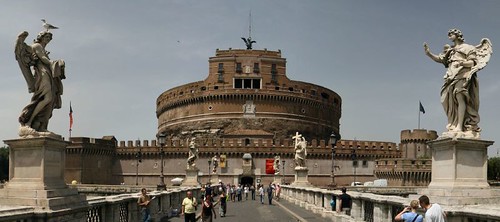
The Castel Sant Angelo in Rome is one of the panoramic images found on the PanoramicEarth.com Tour of Rome. There are over 100 images taken from around Rome linked to an interactive map.
Full 360° panorama of the Castel Sant Angelo V
The Castel Sant Angelo V was originally built by the Roman Emperor Hadrian as a mausoleum for his family and known as Hadrian’s Mausoleum. It served time as a mausoleum, fort, prison, palace and now a museum. The name changed in the 6th Century when Pope Gregory the Great saw a vision of St. Michael on top of the building while praying for deliverance from a plague affecting Rome at the time. This is commemorated by a bronze statue on top the building overlooking Rome and sheathing a sword.
The first building was constructed between 135 and 139 AD. The ashes of Hadrian were buried here in 138 and succeeding emperors were buried here up to 217 AD, probably in the Treasury Room at the heart of the building.
In the 5th century the Mausoleum was converted into a fortress and incorporated into the defensive Walls built around Rome. The contents were looted by Visigoths in 410 during the sacking of Rome by Alaric.
Castel Sant Angelo and the Popes:
Pope Nicholas III connected the castle to the Vatican in the 14th century with a fortified, covered corridor called the Passetto di Borgo. During the sacking of Rome in 1527 Pope Clement VII took refuge here whilst back at the Vatican the Swiss Guard were slain to a man. Clement finally escaped dressed as a servant after several months watching Rome burn
The Castel Sant Angelo was then converted into both a papal residence, a prison and a place of torture. Paul III built a rich apartment, to make sure in a new siege the Pope had an appropriate place to stay. Leo X built a chapel decorated by Raffaello di Montelupo. Famous prisoners included Giordano Bruno, Cellini and Beatrice Cenci. Executions occurred in the small square interior of the building and skeletons excavated from the site show evidence of torture. In 1901 the building began a 30 year restoration programme and conversion to a museum.
More panoramas from Rome can be found on Panoramic Earth. For more articles on Rome see the Rome Index or select one of the labels at the bottom.
No comments:
Post a Comment